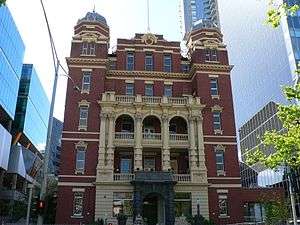Queen Victoria Village
Queen Victoria Village, generally known as QV Melbourne or just QV, is a precinct in the central business district of Melbourne, Victoria, Australia. Covering the city block bounded by Lonsdale, Little Lonsdale, Swanston, and Russell Streets, and located directly opposite the State Library of Victoria and Melbourne Central, QV comprises a large shopping centre, a central plaza, an underground food court, Melbourne central city's first full-size supermarket and apartment buildings.
QV takes its name from the Queen Victoria Hospital, Melbourne which formerly occupied the site.
History of the site


The site was originally the Melbourne Hospital, built in the 1860s and designed in the gothic revival style, it was completey rebuilt between 1911–1912 by architect John James Clark to accommodate a larger number of patients and renamed in honour of Queen Victoria. The hospital was composed of several Edwardian pavilions or loggia, each of them with fanciful domed cupolas except for a corner building, which was based on a square plan and more of the Richardsonian Romanesque style. A women's hospital opened on the site in 1946. The hospital was closed in 1987, and the site was valued at A$63 million in 1987. It was eventually sold for merely $15 million to property developer David Marriner in 1992. All but three of the hospital pavilions were demolished in the following year.
Several options were proposed for the site, including a possible site for the new Melbourne Museum (which was also under consideration for Southbank and Carlton Gardens), and proposals were put forward to integrate the heritage buildings. One such design post modern architects Edmund & Corrigan included giant Egyptian inspired pyramids to tie the pavilions together into a single piece. Carlton Gardens was instead the chosen site for the museum.
During the early 1990s, the site was home to a series of failed ventures, including a craft market, mini golf course, and skateboard rink, before becoming a simple carpark.
Two of the three buildings which remained standing in 1994 were demolished after requests for heritage protection were rejected by then Planning Minister Rob Maclellan. The final remaining building later became the Queen Victoria Women's Centre, and the rest of the site was sold to the country of Nauru, which owned several other sites in the city, notably Nauru House, for $50.3 million.
As the site continued to remain relatively unused and abandoned in the centre of Melbourne's business district, it was called a "bloody disgrace" by then Premier Jeff Kennett. After Nauru struggled to pay for the empty block, it was returned to the Melbourne City Council in 1999, which announced plans to develop the site. Grocon was awarded the tender to develop a $600 million "urban village" on the site.
The development

The "urban village" of QV is a high-density, mixed use precinct containing retail, business, and living spaces. Its different components were designed by several architects: Denton Corker Marshall, Lyons, John Wardle, McBride Charles Ryan and KTA (Kerstin Thompson Architects).
The site is split into four main structures, named QV1 through QV4, two of which are skyscrapers, the remainder being low-rise structures along Swanston Street (owing to strict height limits along the Swanston Street axis). The spaces between buildings were specifically designed as shop-filled laneways, pointing to Melbourne's historic lanes and arcades, many of which no longer exist due to the amalgamation of plots to build office buildings. These new laneways are named for figures in medicine: Jane Bell Lane, Albert Coates Lane, Artemis Lane, and Red Cape Lane. At the centre of the site is an open-air public square, behind the historic Women's Centre.
QV began to open progressively from late 2003, and is now complete.
Queen Victoria Women's Centre
A Trust was established under the Queen Victoria Women’s Centre Trust Act 1994 to govern the Centre, which acts as a statutory authority consistent with the meaning of ‘public body’ in section 3 of the Financial Management Act 1994. The Queen Victoria Women's centre was officially opened in 1997 and refurbished in 2005. The Queen Victoria Women’s Centre offers four venue spaces in the beautiful setting in the heritage building. The venues hold celebratory events, seminars, workshops, exhibitions, board meetings and smaller gatherings.[1] The building is also home to a range of not for profit women’s organisations that offer a range of support and information services to women. Each organisation is independently run. [2]
Offices
The skyscraper located on the corner of Lonsdale and Russell Streets houses offices of Telstra, GHD, Accenture and Australia Post.
Sensis also has its offices at QV, in the building at the corner of Lonsdale and Swanston Streets, and the building immediately north of this. These two buildings are linked by two bridges spanning Albert Coates Lane.
Retail shops
There is a very diverse mix of retailers at QV. Some of the major retailers at QV include:
- Safeway - 11 aisle full line supermarket
- Big W - discount department store
- Harvey Norman/Domayne - furniture and electronics retailer
- Officeworks - office products
As well as retail outlets, there are many options for entertainment at QV. There are many restaurants at QV, as well as bars and a bowling venue.
One of the entertainment options available is Flight Experience, a Flight Simulator based on a Boeing 737-800.
Apartments
Apartments are located in two buildings at QV, both of which are located along Little Lonsdale Street. One of the apartment buildings is the slender skyscraper located at the Russell Street corner, whilst the other is a lower-rise structure on the Swanston Street corner. The latter is low-rise to meet height restrictions on Swanston Street, intended to allow greater viewability of the dome of the State Library of Victoria.
References
- ↑ "Venues". http://www.qvwc.org.au/venues/. External link in
|website=(help) - ↑ "About Us". www.qvwc.org.au/about-us/.
External links
Coordinates: 37°48′36″S 144°57′55″E / 37.810°S 144.9652°E